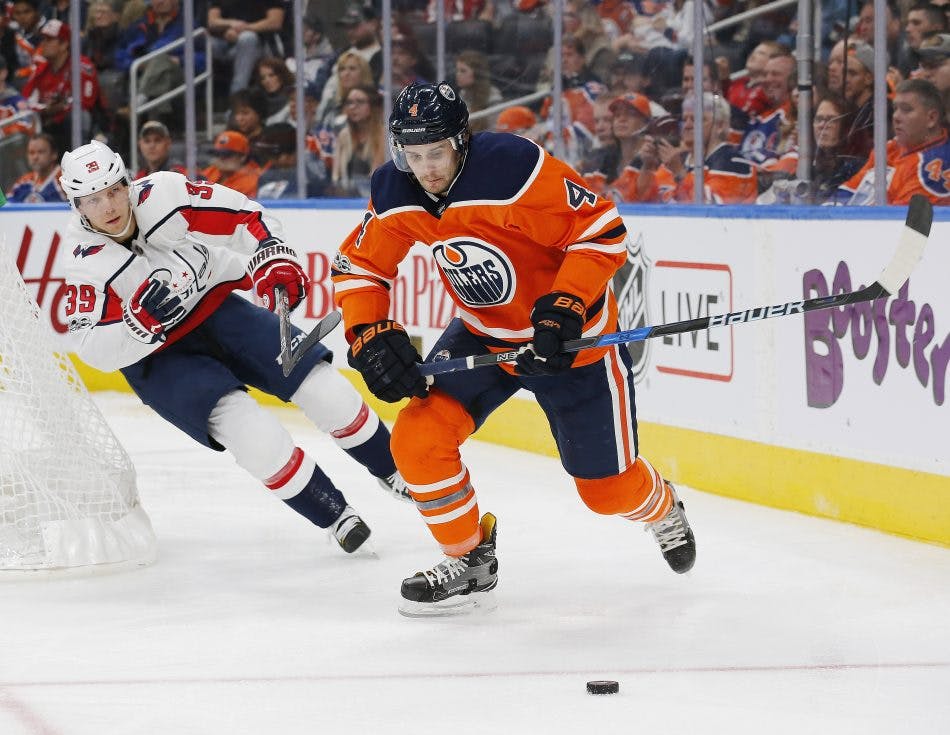How can the Oilers create cap space for 2018-19?

The cap crunch is coming. The Edmonton Oilers currently have nearly $8 million in cap space, according to NHLNumbers. Some will cover Connor McDavid’s entry-level bonuses, but the real concern is when McDavid’s eight-year, $100 million extension kicks in next season and his cap hit jumps to $12.5 million.
McDavid’s contract is not a problem, if anything he might be underpaid in a league that doesn’t accurately value their star players, but it means there’s no room for bloated contracts further down the roster. The Oilers need to surround McDavid, and Leon Draisaitl, with enough talent to win and that means not overspending on players that aren’t difference makers.
The Oilers have $60.946 million already dedicated to 13 players: seven forwards, four defencemen, and two goalies.

The bulk of the roster is there. Can they fill out the rest with $20 million (assuming an $80-million salary cap)?
The Oilers have six restricted free agents of note: Darnell Nurse, Ryan Strome, Matt Benning, Drake Caggiula, Brandon Davidson, Anton Slepyshev, and Iiro Pakarinen.
Lets say the Oilers part ways with Slepyshev and Pakarinen and sign the rest. We’ll use Matt Cane’s (@Cane_Matt) 2018 Free Agent Predictions as a reference.

- Strome’s qualifying offer is $3 million, but the Oilers could negotiate a lower cap hit like they did with Zack Kassian last summer.
- For Nurse, I’m using Michael Matheson and Jaccob Slavin’s contracts and putting Nurse in the middle.
- Benning’s last two years are similar to Nathan Beaulieu before he signed a two-year, $4.8-million contract last season.
- Davidson’s a reasonable depth defenceman who could play up in the lineup. His qualifying offer is more, like Strome, but I’m assuming he takes less to stay.
- Jesse Puljujarvi has $2.5 million in potential performance bonuses he could hit, stick tap to Allan Hull at the Copper and Blue for pointing it out. They’d have to keep this in mind or face a possible penalty in 2019-20.
Re-signing all their RFAs and accounting for Puljujarvi’s bonuses leaves Edmonton roughly $5 million to add two wingers and a fourth-line centre, but that means a very similar team returning in 2018-19 and no room for spare forwards. And there isn’t much in free agency.
So what can they do?
Trade or don’t qualify Ryan Strome: Strome’s $3-million qualifying offer is a lot for a third line player on pace for 32 points. The Islanders probably thought Strome was going to take off by the end of this contract. He’s a useful right wing/ centre who could fetch a draft pick at the trade deadline. The Oilers also could just not qualify Strome, making him a free agent at the end of the season. Calgary did this with Joe Colborne after the 2015-16 season and the Penguins did the same with Justin Schultz after acquiring him from the Oilers.
Strome’s contract shows why the Jordan Eberle trade was so poor; Some of that cap space saved went to Russell’s extension, but the one year left on Strome’s deal meant there wouldn’t be much cap saved for 2018-19 if he had a strong season.
Trade a left-handed defenceman: Edmonton’s money is at centre and left-handed defence. The Oilers could sign Nurse to a bridge deal, but that’d still be a lot of money dedicated to left-shot defencemen. Kris Russell is the obvious one to move, but he has a no-move clause and trading him likely require retained salary or money coming back. Andrej Sekera is another option. He’s older, coming off a serious injury, and maybe it’s wise to get out of that deal when you can. But Sekera has a no-move clause as well. Darnell Nurse is young and loved by the organization, so that leaves Oscar Klefbom. Klefbom had an amazing campaign last season but hasn’t matched that level this season.
Trade a centre: McDavid and Draisaitl aren’t going anywhere. Can a Ryan Nugent-Hopkins trade make sense for Edmonton? Sure, but it can’t be another trade where Edmonton significantly downgrades in skill just to shed money or fill a need.
Buy out Kris Russell: The Kris Russell deal was a bad contract the moment it was signed. The no-move and no-trade protection means that it could cost the Oilers a defenceman much better than Russell. The Oilers can’t go into next season with Kris Russell on the right side of second pairing. That leaves him on the third pairing making too much money.
| Year | Savings | Buyout Cap Hit |
| 18-19 | $3.388M | $611k |
| 19-20 | $2.888M | $1.111M |
| 20-21 | $388K | $3.611M |
| 21-22 | -$1.111M | $1.111M |
| 22-23 | -$1.111M | $1.111M |
| 23-34 | -$1.111M | $1.111M |
A Russell buyout immediately frees up three million next season and nearly another three million in 2019-20. The problem is the massive penalty in 2020-21. The salary cap going up every year should help with expansion in Vegas and likely Seattle, but that’s still a lot of dead money in a year the Oilers should be contending.
Trade Zack Kassian: Kassian’s a valuable player, but that’s a costly cap hit for a fourth-line player. The Oilers could find a similar player for nearly a million less.
The salary cap rising will help, but only a little. Improving the roster will be even more difficult with McDavid’s entry-level contract ending and huge salary locked into overpaid veterans with no-move and no-trade protection.
Recent articles from Christian Pagnani





